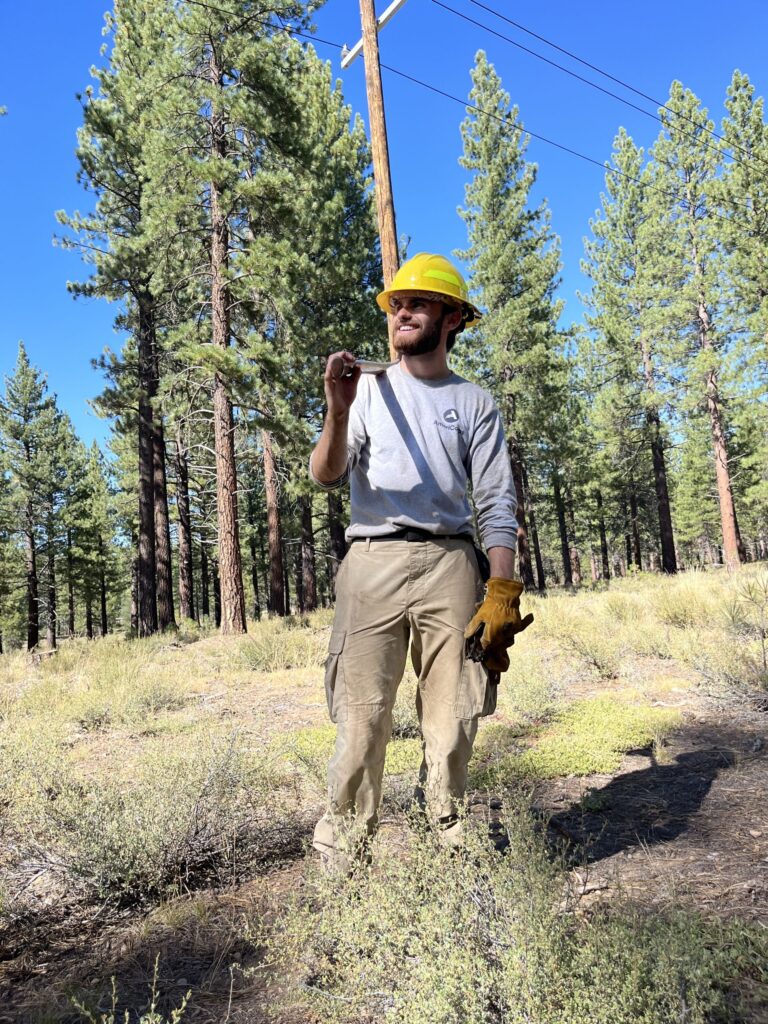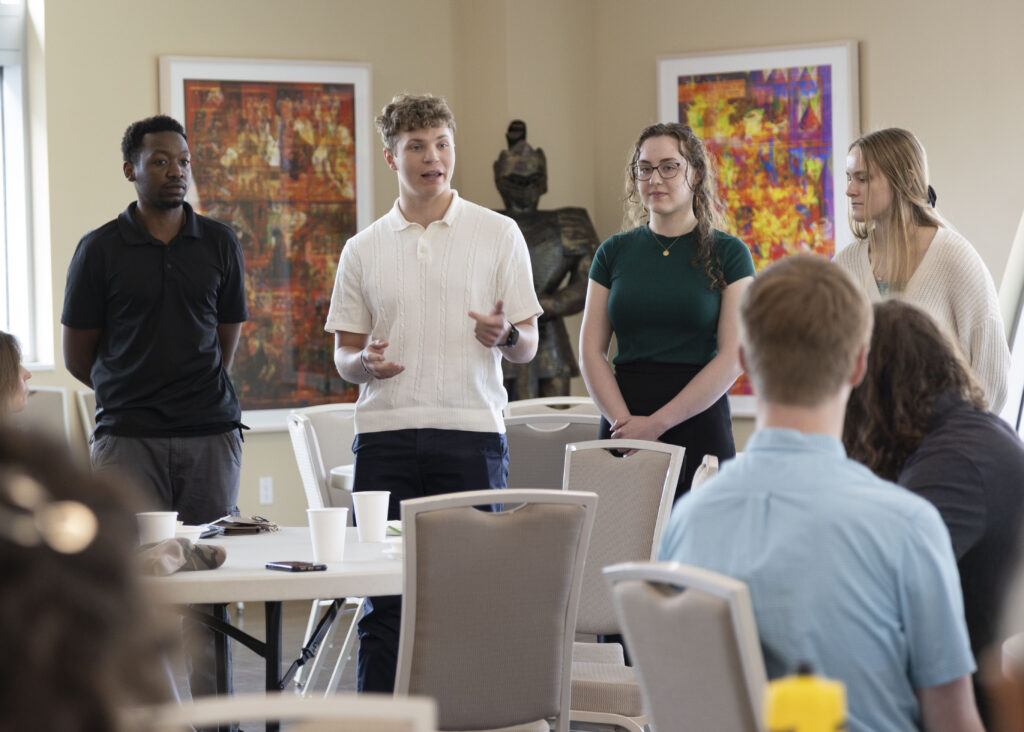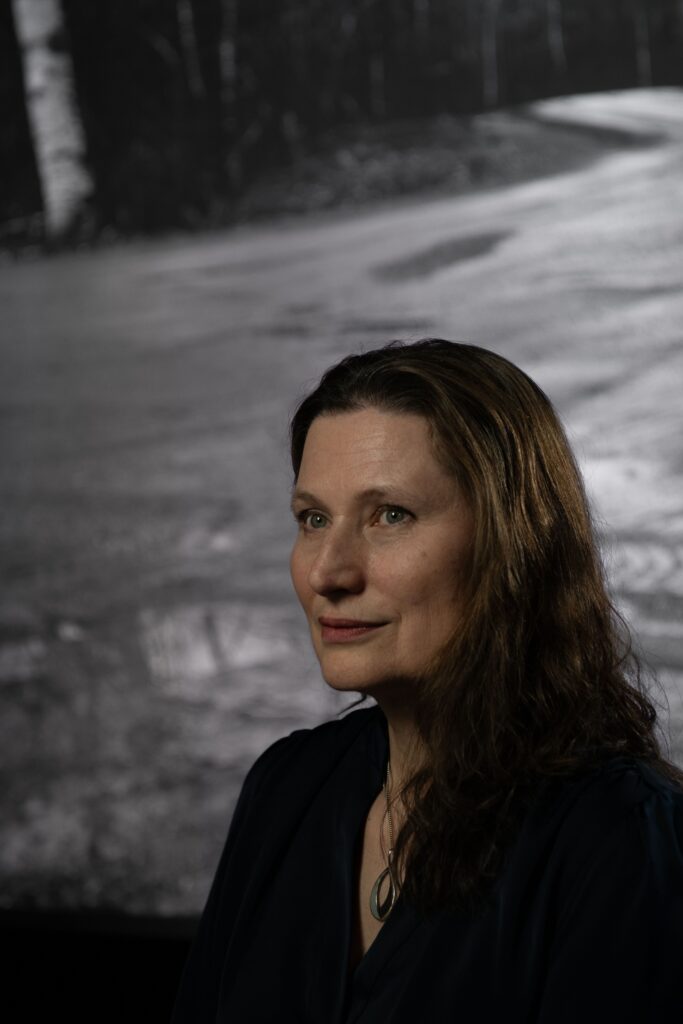Art meets science to produce mural of biodiversity

The header image shows the mural created by students in a Drawing 1 Class this past semester titled: “Biodiversity: Drawing in Nature” being placed on the wall of Cheray 123. Above, the class members in front of their creation after its recent installation. (photos courtesy of Valerie Hird)
At first glance from across the room, a newly placed mural on the wall of the Saint Michael’s College Environmental Sciences lab in Cheray 123 looks to be an attractive black-and-white graphite pencil drawing of a rugged island in the sea.
And so it is. But look closer: Focused inspection reveals multiple same-sized rectangular cells, each a distinct and wonderful world of its own, placed together side-by-side and up-and-down as a grid to constitute the larger island image. Each individual cell, explains this project’s originator, adjunct Valerie Hird of the College’s art faculty, is one student’s well-researched natural-history drawing born of the best kind of cross-discipline collaboration in the liberal arts.
This fall semester, Hird’s Drawing 1 students collaborated with Professors Declan McCabe and Karen Talentino from the Environmental Studies Department to create a hand-drawn mural of the biodiversity found in the Galapagos Archipelago off the coast of Ecuador.
The effect of the class’s 20 drawings placed properly together is a nifty intentional visual legerdemain. For example, a mural section that looks at a distance to be simply a rocky piece of coast running into the sea within this larger image might also, on closer study, contain a creative but real-life-based image of, say, a whale, or a snake, or a blue-footed booby bird — all Galapagos native species – presented in an original creative interpretation by the student artist.

Fernandina Island, upon which the mural was based.
The key, Hird says, is that dark and light values in each drawing had to correspond to a map she and the class created first to assure the drawing would become the larger overall image of the Galapagos island of Fernandina. Such a technique has its roots hundreds of years ago in Islamic, Indian or Persian art, this “hiding” of richer information within the lines and colors of an image.
Hird, a Saint Michael’s adjunct for 18 years, said her Drawing 1 class this semester was titled “Biodiversity: Drawing in Nature,” and focused as a first-time trial on exploring natural history illustration in consultation with her collaborating professors from the sciences. Natural history illustration is a viable career field, with jobs out there for those demonstrating an interest and ability, says Hird. All three collaborating professors said they were excited by the experience, outcomes and possibilities of this experiment.
Talentino explains: “It’s a wonderful model and example of the type of interdisciplinary teaching and learning that takes place here at Saint Michael’s College and a great collaboration among faculty across disciplines,” said the former longtime vice president for academic affairs, who has visited the Galapagos herself as a scientist and photographer only two years ago. As chance would have it, Hird also visited the Galapagos last January accompanying her son-in-law, an environmental studies scholar at another college.
It was during that visit that she got the idea for this recent project, Hird says, and with the support of the St. Mike’s scientists, was able to run with it. She explains her moment of epiphany:
“I was on Fernandina Island looking across a very stark landscape, pretty much black and white, seeing how beautiful it is, but when I put field glasses on it, what I thought were rocks were iguanas, like a Hitchcock moment — everything I thought I was looking at wasn’t what I thought,” Hird recalls. “These ‘rocks’ were really piles of and piles of marine iguanas! … and I thought, ‘I want to do that; I want you to think that you’re looking at a landscape, but closer, you’re actually looking at all the things that live on that island.’”

The species represented by each individual drawing placed in the same order as in the mural
Her next step once home was planning the practical aspects of making it all come together in an introductory drawing class. Each of her students – many non-art majors fulfilling a requirement within the core curriculum – were assigned to choose topics for research, focused on the Galapagos’ unique environment. “Over several workshops they drafted a series of natural history illustrations to visually describe its biodiversity and they embedded their drawings within the landscape of Fernandina Island,” Hird said. “Working together to match the existing values and contours of the island, they created a 20-piece mural describing the rich complexity of life within this stark and fragile environment.” During the semester the students met once a week on Thursday evening for three hours at Sloane Art Center on North Campus to collaborate.
To Hird, it feels as if the College might be organically carving out a marketable niche for those interested in environmentally-focused art, given projects like this recent one in her class and the fact that Department full-time art faculty member, Brian Collier does such environmentally themed projects in his own art regularly.
Hird expressed great gratitude to McCabe, Talentino and Fine Arts Chair Nathaniel Lew for their help and approval for the course. “They were incredibly kind and open to this new idea,” she said. “I would also like to acknowledge the students who embraced this new syllabus and made it their own. Each brought his or her individual interpretation to the project’s concept, and with no grumbling, and put all the hours into making the mural a success. They also contributed fantastic ideas for a video that the class produced about this project.”

Students putting up the mural.
The mural was completed on December 6 and then installed in Cheray on the wall of the Environmental Studies laboratory on the building’s first floor (Cheray 123). Next to the installed artwork, Hird a few days later placed a map linking each section of the mural to the students’ written summaries. Eventually she’d like also to share links so viewers can delve online into the student-research behind each drawing.
An offer they couldn’t refuse
McCabe and Talentino both initially said they imagined a more traditional sort of wall mural being created in bright colors in the hallway of the environmental studies wing when Hird brought them her general idea, but once they understood the concept better, they supported the work with equal enthusiasm.
Each scientist spoke to the art class about the Galapagos, with Talentino describing her trip there two years ago as biologist and McCabe talking during another class about “the evolution and natural history and Charles Darwin and the relevance of that for the Galapagos,” Talentino said. Students used the scientists as resources as they researched the animals they were drawing.
It’s really fantastic,” Talentino said of the final project, likening the drawings to pixels in a photograph. “I’m hoping we can find a better place to post it eventually — maybe Dion Family Student Center, where more can see it, particularly prospective students and families.”
One concern will be figuring a way to protect the individual drawings on paper better than currently on the lab wall. “It would be great if could put it in a more public location,” she said..

Students working in their Sloane classroom at light tables on their individual drawings.
McCabe said for him, the collaboration “has been a lot of fun and produced a wonderful final product. During my meeting with them the students came to the Biology Department and sketched specimens from our collection, and along with the skulls and insects were several whole plants from the College’s farm. When the class was over, one student gathered up the eggplants and other edibles and brought them to the dorm to cook, and he came back the next day to deliver meals to myself and Professor Hird. So in addition to amazing art being produced, some amazing Chinese food was an unexpected surprise from this wonderful collaboration.” McCabe sad that said based on this first experience, “I am certainly interested in pursuing additional collaborations with the Fine Art Department.”
The artist’s view
Hird, who “tends to be project-oriented” in her classes, seized on the principal idea of a collaborative piece when planning the project. “What was so awesome about the students is that each one interpreted it their own way, so the result of the whole is a diverse interpretation of biodiversity,” she said.
“Students were challenged with something that essentially had no precedent and they just seized on it and they enjoyed the idea of the challenge,” she said. “That’s why I love Saint Michael’s students — because they just do it!”
Another part of the experience “that just turns me on,” she said, is that many students in class were not initially art-oriented since they were (mostly) science majors, so she feels privileged to witness the moments when “they transfer over to from text-based decisions to visually-based decisions — that’s so fun to watch. It’s like learning a foreign language — there’s that moment that they say ‘Oh, I get it!”

A single student drawing of a seal, with a numbered grid showing dark and light values as a guide beneath it.
“Natural history illustration is not just a pretty picture,” she said. “It also has to zero in on additional pieces of information that you’re giving.” In this project, that information-delivery had to happen “within the contours and values of the overall image, which was a challenging part they had to wrap their brain around; and to my amazement, they really got it without any previous image to go on. I couldn’t show them a previous example because there wasn’t any.”
“I would absolutely do this again — I had just a blast,” said Hird, who during the semester had discussions about “working with botany/biology in projects they’re doing documenting visually along with text-based.” The whole exercise was a great lesson in collaboration too, the artist said.
“The things that happened in that drawing happened only because it was collaborative. For instance Kyle Fallon did his on various kinds of snakes… and that theme was taken up by Becca who used these kind of scaly rocks behind her flamingos … which was taken up by Sammy who only continued that theme in her rocks. None of that would happen just individually.”
Students in the drawing class who contributed to the mural were: Jasmin Daigle-Arnold, Spenser Edwards, Tess Bennett, Kyle Fallon, ‘Dee’ Deng, Bekka Fila, Tristan Deveault, Caroline Giuliano, Colin James, Lucas Kirsch, Evan Lagerberg, Coleman Maguire, Aidan Maron, Meghan Meyers, Hannah Mishriky, Hannah Muse, Sammy Orciari, Kassy Weston, Bailey Windhom, Jackie Winkler.
Collaborative projects excite her “because of the accidents and impulsive gestures that happen when people work collaboratively together — not to mention the bonding thing, which happened over donuts and cookies for us!” Hird said.





